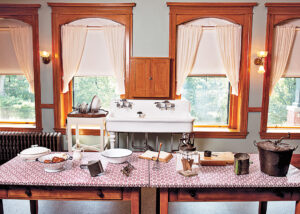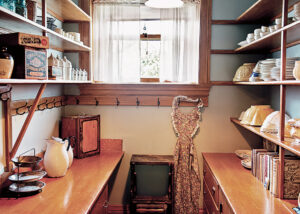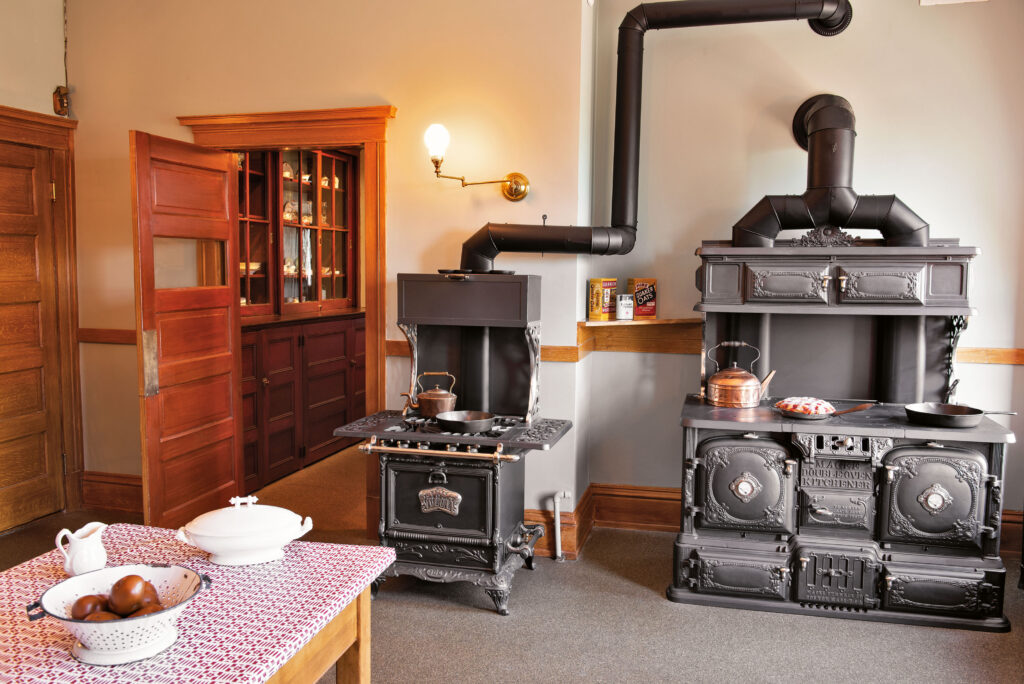In May 2024, Longyear Museum successfully completed a thorough restoration of 400 Beacon Street, the final residence of Mary Baker Eddy, the Discoverer, Founder, and Leader of Christian Science. In this online series, we reprise “‘The Dearest Spot on Earth’” from the 2024 issues of the Longyear Review, taking readers on a tour through the interior of the immaculately restored house in Chestnut Hill, Massachusetts. Rooms from Part 1 of the series wre placed online between October 2024 and January 2025. Starting this month, we will regularly add a new room from Part 2 of the series to the “itinerary.”
What happened in this room?
As was the norm in the Victorian era, the kitchen at 400 Beacon Street was originally relegated to the basement. Relocated upstairs during the 1907 renovation prior to Mrs. Eddy’s arrival, this light-filled space hummed with activity from dawn to dusk, as meals were prepared for a household of about 20. It was a thoroughly modern workspace for its time, well-equipped with two large pantries, an icebox, a double sink, and two stoves—along with a butler’s pantry that offered additional sinks (imagine the mounds of dishes!), storage, and a dumbwaiter to ferry Mrs. Eddy’s meals upstairs. When chores were finished, the staff could relax in the adjoining sitting room or on the breezy porch. The kitchen was presided over by several cooks and assistants, who produced a steady stream of hearty New England fare, including Mrs. Eddy’s favorite “company” meal she loved serving guests—a turkey dinner with all the trimmings.

A tale of two stoves: When Longyear acquired 400 Beacon Street in 2006, the kitchen was missing the pair of stoves pictured in historic photographs. The smaller Vulcan gas range was eventually found in the basement, but the majestic coal or wood-fired Magee Double Oven Kitchener range had long since vanished. A lengthy search for a suitable replacement proved fruitless until consultant Dave Erickson of Erickson’s Antique Stoves in Littleton, Massachusetts, was hired to restore the Vulcan. In a happy turn of events, he had a nearly identical Magee in his own kitchen. Dave was persuaded to sell the rare model and notes that he was honored to be a part of the restoration project.
Faux finish: Craftsmen from Arteriors of Natick, Massachusetts, used a “staining and graining” technique to match the original finish of the woodwork in the kitchen wing. This was common practice in Mrs. Eddy’s day, as labor was inexpensive, allowing for common wood like pine to be painted to appear like a grander choice—in this case, oak. An expert touch was and still is called for, as the wet stain is carefully finished to imitate the desired wood grain.

Photo at top of page: The Vulcan gas range (left) and Magee Double Oven Kitchener (right) take pride of place in the kitchen. Mrs. Eddy’s china service is visible in the butler’s pantry.
Each “stop” in these freshly interpreted period rooms touches on fascinating details about historic restoration. And it also offers a window into the daily routines of “family” life and the prayer and practical accomplishments that took place during the three years that Mrs. Eddy and her staff lived and worked at 400 Beacon Street (1908–1910).
“The Dearest Spot on Earth”: Part 1
Introduction
The Library (October 2024)
The Dining Room (November 2024)
Mrs. Eddy’s Study (December 2024)
The Pink Room (January 2025)
Calvin Frye’s Office (February 2025)
“The Dearest Spot on Earth”: Part 2
Introduction
The Kitchen (this page)
The West Room (July 2025)
Still to come:
Laura Sargent’s Room
The Sewing Room
